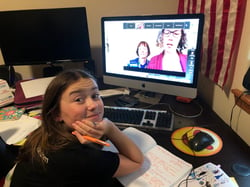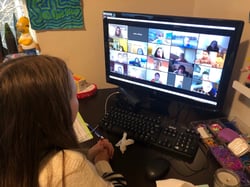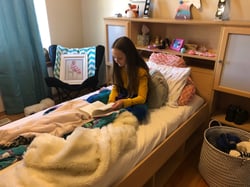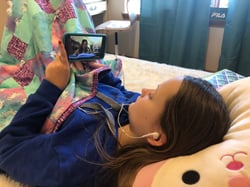My daughters’ school district launched online learning last week, only to be shut down by the state due to issues of inequality. Here’s what I learned observing on-line learning in that short time.
1. Routine was important.
 Everyday, my daughters started the school day by logging into Zoom so that their teachers could take attendance. School started at 9:00, and they had to set their alarm clock. This one simple structure made a huge difference—my daughters had to get out of bed, get dressed (maybe), eat breakfast, and be ready to learn. They were eager to see their teacher and the faces of their peers.
Everyday, my daughters started the school day by logging into Zoom so that their teachers could take attendance. School started at 9:00, and they had to set their alarm clock. This one simple structure made a huge difference—my daughters had to get out of bed, get dressed (maybe), eat breakfast, and be ready to learn. They were eager to see their teacher and the faces of their peers.
The teachers provided a daily schedule that mimicked their school routine. My daughters attended ‘classes’ by logging into Zoom. The teacher provided a short lesson and then students were ‘on their own’ to work on the assignment. If help was needed, they could schedule an appointment with their teacher over Zoom to receive guidance/tutoring. (Both of my daughters used Facetime to work on their assignments with classmates when needed.)
My daughters were given breaks between their classes, and the school day ended at noon. This provided an opportunity for me to have lunch with my daughters and then determine how I wanted my girls to spend their afternoon. As a parent, I appreciated this flexibility; I could follow the suggestions of the teacher for afternoon activities, create my own, or let my daughters select how they wanted to spend their time. One day they baked and decorated a cake, one day they played outside with the neighbor kids, and another day they watched a favorite movie. I also started a read-aloud with them, and we incorporated this into our evening routine.
2. Seeing the faces of teachers and peers made a positive impact.
 The first week we were out of school, the news media cast a tone of fear and anxiety. Rumors were spreading throughout our community that a teacher was sick, and that some of my daughter’s friends were in quarantine. My husband and I had the news on most evenings, and my daughters picked up on our worries and concerns. Despite our attempts to stay calm, fear crept in.
The first week we were out of school, the news media cast a tone of fear and anxiety. Rumors were spreading throughout our community that a teacher was sick, and that some of my daughter’s friends were in quarantine. My husband and I had the news on most evenings, and my daughters picked up on our worries and concerns. Despite our attempts to stay calm, fear crept in.
What seemed to provide reassurance for my daughters was the daily check-in they had with their teachers and their friends.
Seeing the faces over the Zoom classroom provided reassurance that their teacher was ok, their friends were ok, and that everyone would still be there for them when this was all over.
(One of my favorite moments was when my daughter's teacher was startled when her lesson was interrupted by her dog. But the kids loved it! The teacher then instructed all the students to go get their pet and an impromptu show-and-tell occurred mid-lesson.)
3. Initially, content was NOT the goal.
 Initially, the goal was learning new routines and expectations as well as developing skills for independence. Teachers thought of it as starting at the beginning of the year again. At the beginning of the year, teachers invest several weeks of instructional time to setting up classroom routines, teaching rules and expectations, teaching skills for self-management, and building a classroom community and culture. When moving from classroom to cloud, teachers return to these lessons—this time in the cloud.
Initially, the goal was learning new routines and expectations as well as developing skills for independence. Teachers thought of it as starting at the beginning of the year again. At the beginning of the year, teachers invest several weeks of instructional time to setting up classroom routines, teaching rules and expectations, teaching skills for self-management, and building a classroom community and culture. When moving from classroom to cloud, teachers return to these lessons—this time in the cloud.
Formative assessment is key during this time and involves observing students, talking with them, and reading their work to determine their strengths and weaknesses. New strengths and weaknesses will emerge as students shift from classroom to cloud. The strategies and skills students relied on in the classroom may no longer be available in the cloud.
When talking with my daughter’s teacher, she admitted that assessing student performance was the part of on-line learning that overwhelmed her the most. Not only did she have to devise new tools for formative assessment, she found that assessing student work took more of her time in the cloud than the classroom. How do you assess your students when you cannot work with them except over video call? It will take a lot of trial and error before any of us have those answers.
4. The favorite time of the day was still read-aloud.
 Perhaps the best observation of the week was the way read-aloud remained the favorite time of my fifth grader’s school day. I have a beautiful picture of my daughter lying on her bed underneath her blankets with her headphones on and cell phone in hand, listening to and watching her teacher read-aloud a book to the class. Not only does reading aloud build student’s comprehension, and provide equitable access to books, it also is powerful in creating a feeling of comfort and safety in a time of uncertainty.
Perhaps the best observation of the week was the way read-aloud remained the favorite time of my fifth grader’s school day. I have a beautiful picture of my daughter lying on her bed underneath her blankets with her headphones on and cell phone in hand, listening to and watching her teacher read-aloud a book to the class. Not only does reading aloud build student’s comprehension, and provide equitable access to books, it also is powerful in creating a feeling of comfort and safety in a time of uncertainty.
If on-line learning is not possible, for whatever reason, I do believe the one thing we CAN do to reduce the COVID-slide is to continue reading aloud to our children. I will provide more on this topic in an upcoming blogs.
Below are the free on-line tools teachers in the classrooms described above utilized:
- Google Docs
- Zoom
- SeeSaw
- Biblionasium
If you are a teacher using the Read Side by Side Reading Program in an on-line format, we want to hear from you! Please click here to share your story or reach out to us at info@readsidebyside.com
you! Please click here to share your story or reach out to us at info@readsidebyside.com
Written by Sarah Collinge
Founder and President
For more information on teaching virtually, please read our blog post titled, The Ultimate Guide for Teaching Virtually (the C. I. A. Approach)
